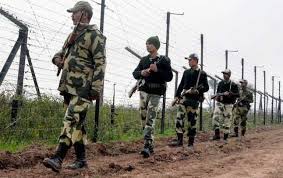Stretches along border with Pakistan remain vulnerable; BSF moves to plug gaps
Date:- 22 Aug 2020

The early morning incident on Saturday, in which the Border Security Force (BSF) personnel shot dead five Pakistani intruders in Punjab’s Tarn Taran sector, has once again pointed towards the vulnerability of certain stretches along the international border to smuggling and infiltration.
According to the BSF sources, recoveries from the dead persons include one AK-47 assault rifle, four pistols, currency notes and a cache of drugs. The intruders were killed after they opened fire on being challenged by the BSF. There had been intelligence reports of increased smuggling activities along the border, sources said.
The area of the incident is the responsibility of BSF’s 103 Battalion. Punjab Police personnel are also on the scene and the task of establishing the identity of the dead is under way.
Also read: BSF shoots 5 intruders near Indo-Pak border in Punjab’s Tarn Taran
Despite additional measures to plug gaps being proposed, especially after the terror attacks in Pathankot and Gurdaspur, the international border in Punjab and Jammu regions remain susceptible to smugglers and infiltrators as some of the projects are yet to take off.
The BSF is responsible for peacetime management of the 2,308-km-long international border with Pakistan from the Chenab river near Akhnoor in Jammu and Kashmir to the Rann of Kutch in Gujarat. A few BSF battalions are also deployed along the Line of Control (LoC) from Akhnoor to Kargil, though guarding the LoC is the Army’s responsibility.
Under the Comprehensive Integrated Border Management System, the BSF had conceived the idea of erecting a “smart fence” along the border consisting of laser walls, thermal imagers and sensors to detect intrusions in places where a physical fence cannot come up due to the terrain.
Riverine stretches along the courses of the Sutlej and Ravi in Punjab and nullahs in the Samba sector south of Jammu are difficult to guard because of the undulating terrain, waterlogging and thick growth of wild grass. The rivers criss-cross the international border at several places.
The length of the international border in Punjab is 553 km, of which only 461 km is fenced.
Two pilot projects for the smart fence, one in the Jammu sector and the other in Punjab were undertaken under the aegis of the Ministry of Home Affairs but no further headway has been made.
“Field reports of the trials are still under process and further course of action will be decided only once these are finalised and appropriate recommendations are put up,” a source said. “Some changes in the structure and format of the fence as well as technological upgradation could be required,” he added.
The procurement of drones for border surveillance as well as counter-drone technology is a major focus area for the BSF. “We are giving a high priority to the use of drones as they are tactically effective. A certain number have already been deployed and more are being acquired,” an officer said.
Since drones are reported to have been used to smuggle weapons and drugs, the BSF has sought a comprehensive system that will have radars, radio frequency receivers, jammers and system controllers to neutralise different types of Unmanned Aerial Vehicles (UAVs). The BSF’s requirement is a ground or vehicle based stand-alone system capable of detecting a lone suspicious flying object or a group of UAVs from a long distance in a 360-degree environment.
The BSF is also conducting trials of portable ground penetration radars to detect cross border tunnels running under the fence, pinpoint land mines and improvised explosive devices or sniff out buried contraband.
“There have been several instances of such tunnels, some several hundred meters long, having been detected and the possibility of more such tunnels cannot be discounted,” an officer said. “The use of tunnels is not a new phenomenon and over the past years the force has carried out large scale operations along the border to uncover tunnels,” he added.
Sources point out that with engineering support from the military establishment, boring long tunnels is not difficult. Their exit could be concealed inside a shack or a barn-like structure near the border or even under dense vegetation or crevice.
Daily Tribune: 22nd August, 2020


